Felipe Calderón
- This article is about the current President of Mexico. For the Filipino politician and historical figure, see Felipe Calderón y Roca.
| Felipe Calderón | |
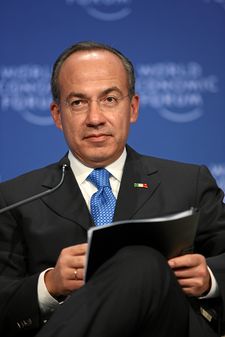 at the World Economic Forum Annual Meeting (in Davos on January 30, 2009) |
|
|
|
|
| Incumbent | |
| Assumed office December 1, 2006 |
|
| Preceded by | Vicente Fox |
|---|---|
|
Secretary of Energy
|
|
| In office September, 2003 – June 1, 2004 |
|
| Preceded by | Ernesto Martens |
| Succeeded by | Fernando Elizondo Barragán |
|
16th President of the National Action Party
|
|
| In office 1996–1999 |
|
| Preceded by | Carlos Castillo Peraza |
| Succeeded by | Luis Felipe Bravo Mena |
|
|
|
| Born | August 18, 1962 [1] Morelia, Michoacán, Mexico |
| Birth name | Felipe de Jesús Calderón Hinojosa |
| Political party | National Action Party (PAN) |
| Spouse(s) | Margarita Zavala |
| Residence | Los Pinos (Official) |
| Alma mater | Escuela Libre de Derecho, Instituto Tecnológico Autónomo de México and Harvard University |
| Occupation | Politician |
| Religion | Roman Catholic[2] |
Felipe de Jesús Calderón Hinojosa (Spanish pronunciation: [feˈlipe kaldeˈɾon]; born August 18, 1962) is the current President of Mexico. He assumed office on December 1, 2006, and was elected for a single six-year term through 2012. He is a member of the National Action Party (PAN), one of the three major Mexican political parties.
Calderón was elected in the 2006 presidential elections. The results were contested by his closest opponent, Andrés Manuel López Obrador, who started what he called a "pacific civil resistance". Calderon's victory was confirmed on September 5, 2006 by the Federal Electoral Tribunal.
Prior to the presidency, Calderón actively participated in PAN politics. He has served as National President of the Party, Federal Deputy, and Secretary of Energy in Vicente Fox's cabinet.
Contents |
Background and family life
Felipe Calderón Hinojosa was born in Morelia, Michoacán. He is the youngest of five brothers and son of Carmen Hinojosa Calderón and the late Luis Calderón Vega.
His father was a co-founder of the National Action Party and an important political figure. He occupied state posts and served a term as federal deputy. Calderón spent most of his life working within the party and spent most of his free time promoting the PAN.
After growing up in Morelia, Calderón moved to Mexico City, where he received a bachelor's degree in law from the Escuela Libre de Derecho. Later, he received a master's degree in economics from the Instituto Tecnológico Autónomo de México (ITAM) and a Master of Public Administration in 2000 from the John F. Kennedy School of Government at Harvard University.[3]
Following his father's example, he joined the PAN. His father had quit in 1981.
It was in the National Action Party where Calderón met his wife, Margarita Zavala, who served in Congress as a federal deputy. They have three children, María, Luis Felipe and Juan Pablo. Before becoming president of Mexico, he lived in Colonia Las Águilas, in southern Mexico City.[4]
Political career
Calderón was president of the PAN's youth movement in his early twenties.
He was a local representative in the Legislative Assembly and, on two different occasions, in the federal Chamber of Deputies. He ran for the governorship of Michoacán in 1995 and served as national president of the PAN from 1996 to 1999. During his tenure, his party maintained control of 14 state capitals, but also lost presence in the federal Chamber of Deputies.
Soon after Vicente Fox took office as president, Calderón was appointed director of Banobras, a state-owned development bank. He was accused by political opponents of committing abuse during his tenure, by using a legal process[5] to borrow between three[5] and five million pesos[6] (the amount varies according to the source) to pay for his home acquisition at Las Águilas, a high-class neighborhood in Mexico City.[4] After political accusations over the matter arose, he stopped and instead went about the acquisition through different means.[6]
Later on, he joined the presidential cabinet as Secretary of Energy, replacing Ernesto Martens. He left the post in May 2004 in protest of Vicente Fox's criticism of his presidential ambitions while supporting those of Santiago Creel.
Presidential campaign
Members of his party chose him as the PAN presidential candidate in a series of three primary elections at the end of 2005. In these elections, he defeated former Interior Secretary Santiago Creel and former Governor of Jalisco Alberto Cárdenas by a comfortable margin.
Santiago Creel was said to be, at the time, the preferred candidate of President Vicente Fox, and thus the election of Calderón as party candidate surprised many analysts. The PAN pointed to this primary election as a signal of "internal democracy", contrasted by the election processes of the other parties. The PRD had only one pre-candidate, Andrés Manuel López Obrador, and the PRI, while having a nationwide primary open to anyone, even non-party members, eliminated all strong candidates that opposed Roberto Madrazo. Indeed, the only pre-candidate that opposed Madrazo got less than 5% of the internal vote.
Calderón accepted his party's nomination on December 4, 2005, and began his campaign on January 1, 2006.
Criticism of Calderón during the presidential campaign was generally aimed against his social or economic stances. One of the chief accusations made by his political opponents centered on the loan made while serving as state-owned development bank director (see Political career), an alleged involvement in organizing a bank-rescue fund to prevent solvency problems during the PRI-regime (Fobaproa)[7] and granting contracts to a embattled software company founded by his brother-in-law during Calderón's eight-month tenure as Secretary of Energy (Hildebrando). His opponents also claimed that Hildebrando developed the vote counting system to be used in the presidential election, a claim that was dismised after an audit commissioned by the Federal Electoral Institute.[8]
Calderón's campaign gained momentum after the first presidential debate. Subsequent poll numbers showed a steady increase in his popularity and put him ahead of López Obrador from March to May; some polls favored him by as much as nine percentage points. This trend ceased after the second presidential debate as his opponent began attending. Final poll numbers days ahead of the results indicated that his opponents prior lead had shrunk further; some polls gave López Obrador the lead, while others favored Calderón and still others indicated a technical tie.
Political and social views
Calderon describes himself as a devout Catholic[2] and as such personally opposes euthanasia,[9] unrestricted abortion,[9] and gay marriage.[10] Nevertheless, he supports current Mexican legislation guaranteeing abortion for rape victims, when pregnancy endangers a woman's life or in cases of severe fetal deformity;[11] has publicly advocated the legalization of small quantities of cocaine and other drugs for addicts who agree to undergo treatment;[12] and has approved a right-to-die law that allows terminally ill patients to refuse invasive treatment or extraordinary efforts to prolong their lives.[13] As for his economic policies, he supports balanced fiscal policies, flat taxes, lower taxes,[14][15][16] and free trade.
During his presidential campaign Calderón stated that the challenge was not between the political left or right, but a choice between the past and the future. Moving toward the past would mean nationalization, expropriation, state control of the economy, and authoritarianism, while the future would represent the contrary: privatization, liberalization, market control of the economy, and political freedom.[17]
Post-election controversy
On July 2, 2006, the day of the election, the Federal Electoral Institute (IFE) announced that the race was too close to call and chose not to make public a large and well-designed exit poll. However, as the preliminary results of the unofficial PREP database made clear the next morning, Felipe Calderón had a small lead of 1.04%.[18]
The IFE called the candidates to abstain from pronouncing themselves as winner, president-elect, or president. Both candidates disobeyed this call. First López Obrador declared that he had won the election, and soon thereafter Calderón proclaimed victory as well, pointing to the initial figures released by the Federal Electoral Institute (IFE).[19]
On July 6, 2006, the Federal Electoral Institute announced the official vote count in the 2006 presidential election, resulting in a narrow margin of 0.58% for Calderón over his closest contender, PRD candidate Andrés Manuel López Obrador. However, López Obrador and his coalition alleged irregularities in a number of polling stations and demanded a national recount. Ultimately, the Federal Electoral Tribunal, in a unanimous vote, declared such recount to be groundless and unfeasible and ordered a recount of those with supportable allegations, or about 9.07% of the 130,477 polling stations.[20]
On September 5, 2006, even when the Federal Electoral Tribunal acknowledged the existence of irregularities in the election, Calderón was, after the change of the votes of two of the magistrates,[21] unanimously declared president-elect by the tribunal with a lead of 233,831 votes, or 0.56%, over López Obrador. The electoral court concluded that minor irregularities were insufficient without proof, and they were not enough to invalidate the election. The ruling was mandatory, final, and could not be appealed.[22]
Presidency
Inauguration and cabinet appointments
| OFFICE | NAME | TERM |
| President | Felipe Calderón Hinojosa | |
| Interior | Francisco Ramírez Acuña Juan Camilo Mouriño Fernando Gómez-Mont Francisco Blake Mora |
2006–2008 2008 2008–2010 2010– |
| Foreign Affairs | Patricia Espinosa | 2006– |
| Public Safety | Genaro García Luna | 2006– |
| Attorney General | Eduardo Medina-Mora Arturo Chávez |
2006–2009 2009– |
| Health | José Ángel Córdova | 2006– |
| Education | Josefina Vázquez Mota Alonso Lujambio Irazábal |
2006–2009 2009– |
| Economy | Eduardo Sojo Gerardo Ruiz Mateos Bruno Ferrari |
2006– 2008 2008– 2010 2010– |
| Labor | Javier Lozano Alarcón | 2006– |
| Agriculture | Alberto Cárdenas Jiménez Francisco Javier Mayorga |
2006–2009 2009– |
| Energy | Georgina Kessel | 2006– |
| Finance | Agustín Carstens Ernesto J. Cordero |
2006–2009 2009- |
| Communications | Luis Téllez Juan Molinar Horcasitas |
2006– 2009 2009– |
| Defense | Guillermo Galván Galván | 2006– |
| Navy | Mariano Saynez Mendoza | 2006– |
| Presidential Guard | Jesús Javier Castillo | 2006– |
| Social Development | Beatriz Zavala Ernesto J. Cordero Heriberto Félix Guerra |
2006–2008 2008–2009 2009– |
| Environment | Juan Rafael Elvira Quesada | 2006– |
| Tourism | Rodolfo Elizondo Torres Gloria Guevara Manzo |
2006–2009 2010– |
| Civil Service | Germán Martínez Salvador Vega Casillas |
2006–2007 2007– |
The Mexican Constitution states that the President must be inaugurated by taking the oath of office before Congress in the lower house, the Chamber of Deputies. The PRD opposition had threatened to not allow Calderón to take the oath of office and be inaugurated as president. Ahead of claims that the PRD would disrupt the precedings, the PAN took control of Congress's main floor three days before the inauguration was scheduled.
On November 30, 2006,[23] outgoing President Vicente Fox Quesada and still President-Elect Felipe Calderón Hinojosa stood side by side on national television as Fox turned over the presidential band to a cadet, who handed it to Calderón. Afterwards, Fox read a short speech indicating that he had concluded his mandate by receiving the flag "that had accompanied him during the last six years which he had devoted himself completely to the service of Mexico and had the utmost honor of being the president of the republic".[24] Calderón then made a speech to the Mexican public indicating that he would still attend the inauguration ceremony at the Chamber of Deputies. He made a call to unity using words from his presidential campaign.
On December 1, 2006 despite the PRD's plans to prevent Calderón from taking office, the inauguration in front of Congress was able to proceed. Hours before Calderón's arrival, lawmakers from the PRD and PAN parties began a brawl,[25] where several representatives threw punches and pushed, while others shouted at each other. PRD representatives shouted "Fuera Fox" ("out with President Fox") and blew whistles, while PAN representatives responded back with "Mexico, Mexico." Minutes before Calderón and Fox walked into Congress, the president of the Chamber of Deputies announced legal quorum, thus enabling Calderón to legally take the oath of office. At 9:45 a.m. CST, all Mexican media cut to the official national broadcast, where commentators discussed the situation, and showed scenes inside the Palace of the Chamber of Deputies, Palacio de San Lázaro. At 9:50 a.m. CST, Calderón entered the chamber through the back door of the palace and approached the podium, where he took the oath as required by the Constitution.[26] After the anthem, opposition continued to yell in Spanish "Felipe will fall." PAN representatives shouted back, "Sí se pudo" (Yes it was possible to do).[27][28] At 10:00 a.m. CST, the official broadcast ended, and most stations resumed their programming.
As the inaugural ceremony was transpiring in Congress, López Obrador led a rally of supporters in the Zócalo. Many supporters marched down Reforma Avenue toward the Auditorio Nacional, where Calderón would address an audience of supporters after his inauguration.[29][30]
Domestic policy
During the first months of government, President Calderón took several actions that impacted his image in Mexico and beyond, particularly in Europe and in the United States. Some of these actions, such as the Tortilla Price Stabilization Pact and a cap on the salaries of public servants, have been interpreted as "seeking to fulfill a campaign promise to incorporate the agenda of election rival Andrés Manuel López Obrador into his government".[31]
The Wall Street Journal has said that Calderón has risked the possibility of reforms in Mexico by "reaching out to traditional power brokers, forging alliances with everyone from union bosses to billionaire television moguls", in a strategy that "has bolstered the president's otherwise weak political position," but "may prevent him from making the deep political and economic changes Mexico needs to modernize".[32][33]
On January 18, 2008 the Inter-American Dialogue and the Woodrow Wilson Center’s Mexico Institute welcomed one of Mexico’s most highly regarded political analysts, Denise Dresser, to offer her perspective on the successes and failures of President Felipe Calderón’s first year in office. Dresser called Calderón’s first year a good beginning, characterizing it as prudent, pragmatic, and measured. She praised his ability to establish the presidential authority he needed after a highly contested election, and acknowledged that his steadfast efforts in building consensus have produced some of the reforms Mexico’s previous administration could not achieve. By making the issues of public security and fiscal, pension and electoral reform the vanguard of his agenda, Calderón has demonstrated his capabilities to effectively govern Mexico. She also pointed out that he had been forced to make important political concessions, which may have long-term negative consequences for democracy in Mexico.[34] Later, Denise Dressers's opinions on Felipe Calderón's administration swiftly became increasingly critical as reflected in an open letter published on September 2008 where she withdrew her former praises and claimed that President Calderón had made many wrong decisions by joining forces with what she called the "defenders of statu quo" (PRI,SNTE) losing the authority he had won on his first year of Administration.[35]
Foreign policy

It is expected that Calderón will continue with the foreign policy started during Fox's term,[36] known as the Castañeda Doctrine, in abandonment of the Estrada Doctrine. He has been expected to mediate with 'free market' Latin American countries.[37]
Calderón has been a proponent of the Puebla-Panama Plan (PPP),[38] started during the Fox administration. However, more than a simple continuation, Calderón has expanded the PPP, now including Colombia,[39] and an agreement of cooperation against organized crime.[40] Jorge G. Castañeda, Secretary of Foreign Affairs during the first half of Fox's administration and proponent of the "Castañeda Doctrine", has suggested that Calderón's leadership and the PPP should be used as a counter-part to Hugo Chávez's leadership of left-wing policies in Latin America.[41] Calderón has stated that "the challenge (of the PPP) is to foster democratic practices with solid foundation in the region".[42]
Another landmark has been the proposed Mérida Initiative, a security cooperation initiative between the United States and the government of Mexico and the countries of Central America, with the aim of combating the threats of drug trafficking and transnational crime.
Immigration reform
Felipe Calderón has made immigration reform one of his main priorities.
Before meeting with President Bush in March 2007, Calderón openly expressed his disapproval of building a wall between the two nations.[43] After the U.S. Senate rejected the Comprehensive immigration bill, President Calderon called the decision a "grave error".
Economic policy
Tortilla Price Stabilization Pact
The international price of corn rose dramatically throughout 2006, leading to the inflation of tortilla prices in the first month of Calderón's term. Because tortillas are the main food product consumed by the country's poorest,[44] national concerns over the rising prices immediately generated political pressure on Calderón's administration.
The president opted to use price ceilings on tortillas that protected local consumers of corn.[45] This price control came in the form of the Tortilla Price Stabilization Pact between the government and many of the main tortilla producing companies, including Grupo Maseca and Bimbo, to put a price ceiling at $8.50 pesos per kilogram of tortilla. The hope was that a ceiling on corn prices would provide incentive for the market to lower all prices nationally.
Critics argue that the pact was both nonbinding and a de facto acceptance of a 30% increase in the price of that product (from $5.95 pesos per kilogram to $8.50 pesos per kilogram).[46][47][48] Many tortillerias ignored the agreement, leading to price increases well in excess of the $8.50.[49] Government opposition sees this as an indication of the failure to protect the interests of its poor citizens.
However, several major supermarkets, such as Soriana and Comercial Mexicana, sell the tortillas at a lower price than the one in the agreement — as low as $5.10 pesos per kilogram[50] — which is interpreted by liberals as evidence that price controls and the Tortilla Price Stabilization Pact were unnecessary. Additionally, PROFECO, a consumer protection government organization, has also threatened with jail those tortilla producers who charge "excessive" prices.
Three months after the pact was signed, the Secretariat of Economy informed the public that the price of tortillas was reduced in most of the 53 main cities of Mexico. However, in 27 cities and 15 states, the price remained above the agreed $8.50 pesos. In Tijuana, Morelia, San Luis Potosí, Ciudad Victoria, and Nuevo Laredo, the price of tortillas had risen despite the fact that the average price of corn has dropped from $3,500 pesos per ton to $2,500 pesos per ton. However, the director of the Maize Industry Council has defended the pact by minimizing the price increments in those cities, claiming that the pact was only intended for the Valley of Mexico, and not the whole country.[51]
Guillermo Ortiz, governor of the Bank of Mexico, labeled the agreement "a success" for consumers and urged for it to continue as means to combat rising inflation.[52]
First Employment Program
Fulfilling an electoral promise, President Calderón launched the First Employment Program, which aims to create new opportunities for people entering the job market. The program will give cash incentives to companies for hiring first-time job holders, including young people graduating from higher education and millions of women who have never worked.[53]
The program has been interpreted as an effort to stop immigration into the United States.[54]
Reactions to this program have been mixed. The president of the Mexican Association of Directors in Human Relations, Luis García, has anticipated a positive effect and even showed Nextel's subsidiary in Mexico as an example for hiring 14% of its new workforce in 2006 as people in their "first employment".[55]
However, other groups have criticized this program as being insufficient. Secretary of Labor Javier Lozano Alarcón has admitted that the program will be insufficient to create as many new jobs as needed and has called for deeper reforms to allow for further investment.[56]
Public servants salary cap
President Calderón announced, on his first day as president, a presidential decree limiting the president's salary and that of cabinet ministers. The measure only affects a few high-ranking officials, but excludes most of the bureaucracy and public servants in the legislative or judicial branches. According to a Freedom of Information Act request filed by Reforma, the decree will affect 546 high-level government officials and save the government about US$13 million.[57] The opposition has stated that the 10% reduction in salary as not being comprehensive enough.[58][59]
Calderón later launched a proposal for a constitutional amendment that, if passed, would significantly lower salaries for all public servants in all three branches of government and impose a cap on compensation.[60] The proposal also includes measures to make the remuneration of public servants more transparent and subject to fiscalization.[61]
Security policy
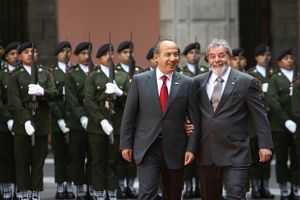
Despite imposing a cap on salaries of high-ranking public servants, Calderón ordered a raise on the salaries of the Federal Police and the Mexican armed forces on his first day as president.
Calderón's government also ordered massive raids on drug cartels upon assuming office in December 2006 in response to an increasingly deadly spate of violence in his home state of Michoacan. The decision to intensify drug enforcement operations has led to an ongoing conflict between the federal government and the Mexican drug cartels.
On January 19, 2007, Mexico captured the leader of one of its seven major drug cartels, the Diaz Parada gang, five weeks into an army crackdown on narco gangs. Mexican soldiers and federal police jointly arrested Pedro Diaz Parada, whose cartel has operated across southern Mexico, on Tuesday in the southern city of Oaxaca, a spokeswoman for the attorney general's office said.[62]
The next day, in a controversial move, the government announced the extradition to the United States of several drug gang leaders.[63]
The Mexican government has also ordered Mexican soldiers and Federal Police into several cities, most notably, Tijuana and Ciudad Juárez. In Tijuana and also Ciudad Juárez, the army ordered that all local police officers surrender their weapons, as it is suspected that many officers have ties with drug cartels. Other states where actions have been taken include Michoacán, Tamaulipas, Tabasco, and Guerrero.
In an interview with the Financial Times, Calderón said that "we have received very encouraging results. In the state of Michoacán, for example, the murder rate has fallen almost 40 per cent compared with the average over the last six months. People’s support in the regions where we are operating has grown, and that has been very important. Opinion polls have confirmed that, and I think we have made it clear to everyone that this issue is a priority for us".[64]
On April 9, 2007, the Secretariat of Defense announced in a report the results of the first four months of Calderón's presidency. These results include the capture of 1,102 drug dealers, the seizure of about $500 million pesos, 556 kilograms of marijuana, 1,419 military grade weapons, two airplanes, 630 automobiles, and 15 sea ships that transported drugs, and the destruction of 285 clandestine runways, 777 drug camps, 52,842 marijuana farms and 33,019 opium poppy farms. The report claims that these results stopped the distribution of 1,428,124 doses of marijuana, 17,728,000 doses of cocaine, 193,922,000 doses of heroin, and 6,996,000 toxic pills, stopping the intoxication of 647,771,000 people, a lot of them with irreversible damage to their health.[65]
On December 16, 2009, The Mexican Navy killed Arturo Beltran-Leyva, one of the country’s most powerful drug traffickers.[66]
Despite the government's success in detaining drug lords, drug-related violence remains high in contested area along the US border such as Ciudad Juarez, Tijuana, and Matamoros. However, outside the zones of drug-violence, Brookings Institute studies indicate that even under current drug-policies, Mexico has lower death rates than many other nations. According to Brookings Senior Fellow Casas-Zamora's figures, based on United Nations 2008 data, Mexico's murder rate is nearly five times less than that of Jamaica and about half that of Brazil. Honduras has a murder rate of 61 deaths per 100,000 inhabitants, followed by Jamaica with 60, Venezuela and El Salvador with 52 each, Guatemala with 47, Trinidad and Tobago with 40, Colombia with 39, Brazil with 22, Dominican Republic with 21, Panama with 19, Ecuador with 18, Nicaragua with 13, Paraguay with 12, Mexico and Costa Rica with about 11.5 each, Bolivia with 10.5 and Uruguay, Argentina, Peru, and Chile with less than 10.[67]
Homicide rates in Mexico from 2000-2007 show a general decline including all intentional homicides in the country per 100,000 residents: 2000 = 14.11 | 2001 = 13.94 | 2002 = 13.04 | 2003 = 17.5 | 2004 = 11.1 | 2005 = 10.6 | 2006 = 10.8 | 2007 = 10 [68]
Approval ratings
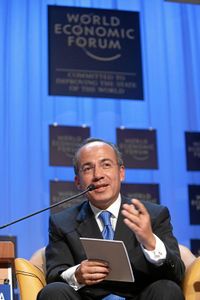
According to a Parametria poll conducted from January 27 to January 30, Calderón's approval rating was 48%. The director of the polling firm, Francisco Abundis, attributed the decrease in Calderón's rating from an earlier 70% principally to the increase in the price of tortilla.[69][70]
However, according to a poll by Grupo Reforma taken from February 16 to February 18, Calderón's current approval rating is of 58%. In this poll, Mexicans interviewed give President Calderón and his actions a score of 6.6 out of 10. He is best rated in his actions on issues related to health and reducing drug trafficking (60% and 59% approval respectively), and worst rated on domestic and foreign policy (33% approval each). Sixty percent of those interviewed judged that honesty was Calderón's best attribute during these first months of government. However, Reforma's breakdown of Calderóns approval rating found that the 54% of the interviewed who thought the 2006 election was legitimate gave the president a 77% approval rating, while the 34% who said they did not think the 2006 election was legitimate gave the president an approval rating of only 34%.[71]
According to a poll published on El Universal,[72] Calderón's approval score increased from 6.5 (from 0 to 10) in January to 7.0 (from 0 to 10) in April. The poll took place from April 26 to May 1, and the figures have a confidence level of 95%. Individuals affiliated to the PAN and PRI gave the highest scores (8.2 and 6.9 respectively), and the biggest increases were seen in members affiliated to the PRI and PRD (1.0 and 0.9 respectively). A more recent poll by Ipsos-Bimsa shows a decrease in Calderon's approval rating, from 64% in August 2007 to 57% in November 2007.[73] In June 2008, Calderon's approval rating jumped to 64% before slipping to 62% in September after a grotesque wave of violent drug-related crimes spread.[74]
According to a March 2010 poll by GEA-ISA. 45 per cent of respondents approved of their president’s performance, down seven points since November 2009.
Orders, awards and recognition
By Mexican Law none of these titles are valid, and the President has accepted them as a courtesy to the foreign governments.
- Bravo Business Awards Leader of the Year, Latin Trade, October 2009.
 Order of the Bath, Knight Grand Cross, awarded by Queen Elizabeth II of the United Kingdom on Felipe Calderón state visit to the United Kingdom, 30 March 2009.
Order of the Bath, Knight Grand Cross, awarded by Queen Elizabeth II of the United Kingdom on Felipe Calderón state visit to the United Kingdom, 30 March 2009.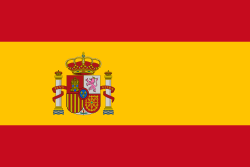 Order of Isabel the Catholic, Grand Cross with Collar, awarded by King Juan Carlos I of Spain on Felipe Calderón state visit to Spain, June 11, 2008.
Order of Isabel the Catholic, Grand Cross with Collar, awarded by King Juan Carlos I of Spain on Felipe Calderón state visit to Spain, June 11, 2008. National Order of Doctor José Matías Delgado, Grand Cross, awarded by the Government of El Salvador, March 4, 2008
National Order of Doctor José Matías Delgado, Grand Cross, awarded by the Government of El Salvador, March 4, 2008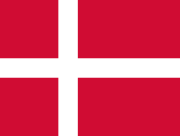 Order of the Elephant, Knight, awarded by Queen Margrethe II of Denmark on her state visit to Mexico, February 18, 2008.
Order of the Elephant, Knight, awarded by Queen Margrethe II of Denmark on her state visit to Mexico, February 18, 2008.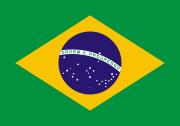 National Order of the Southern Cross, Grand Collar, awarded by the Government of Brazil, August 7, 2007.
National Order of the Southern Cross, Grand Collar, awarded by the Government of Brazil, August 7, 2007.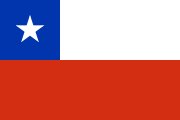 Order of the Merit of Chile, Collar, awarded by the President of Chile Michelle Bachelet on her state visit to Mexico.
Order of the Merit of Chile, Collar, awarded by the President of Chile Michelle Bachelet on her state visit to Mexico. Order of Belize, awarded by then-Prime Minister of Belize Said Musa on Felipe Calderon state visit to Belize.
Order of Belize, awarded by then-Prime Minister of Belize Said Musa on Felipe Calderon state visit to Belize.- Leader of the Year, Latin Business Chronicle, December 17, 2007.
References
- ↑ "Felipe Calderón". Encyclopædia Britannica. Encyclopædia Britannica. http://www.britannica.com/eb/article-9437374. Retrieved 2008-06-09.
- ↑ 2.0 2.1 "Catholic family meeting circles wagons around traditional family". AFP. 2009-01-14. http://www.google.com/hostednews/afp/article/ALeqM5hIo1U4cYgRu7TzDwSqDmWKR6_2yQ. Retrieved 2009-06-23. "Mexican President Felipe Calderon, a self-described devout Catholic conscious of the fact that five million women head single-parent households in Mexico, said a compromise was needed."
- ↑ Doug Gavel (2006-07-07). "Alum is Apparent Winner of Presidential Election in Mexico". Harvard KSG. http://www.hks.harvard.edu/news-events/news/articles/alum-is-apparent-winner-of-presidential-election-in-mexico. Retrieved 2008-06-09.
- ↑ 4.0 4.1 Reyes, Mariusa (2006-07-02). "La jornada del "candidato anticipado"" (in Spanish). BBC Mundo. http://news.bbc.co.uk/hi/spanish/latin_america/newsid_5139000/5139196.stm. Retrieved 2009-06-23.
- ↑ 5.0 5.1 Katia D'Artigues (2003-07-25). "Dice Felipe que siempre no" (in Spanish). El Universal. http://www2.eluniversal.com.mx/pls/impreso/version_imprimir.html?id_nota=32279&tabla=columnas. Retrieved 2009-05-28.
- ↑ 6.0 6.1 Erasmo Fernández de Mendoza (2007) (in Spanish). Conjuras sexenales. Ediciones B - México. ISBN 9707103043 9789707103047. OCLC 191761164. http://books.google.com.mx/books?id=W8MZBQqcOcwC&pg=PA246&lpg=PA246&dq=Banobras+pr%C3%A9stamo+Calder%C3%B3n&source=bl&ots=gcyNWbZiQX&sig=cLNDvTrajxagUeu7m1QF87M2W2Q&hl=es&ei=gJ8eSsCvN47aMezOsfUF&sa=X&oi=book_result&ct=result&resnum=7. Retrieved 2009-05-28.
- ↑ Saúl, Lilia (2006-06-08). "Arturo Núñez justifica la aprobación de Fobaproa" (in Spanish). El Universal. http://www.eluniversal.com.mx/nacion/139210.html. Retrieved 2009-07-07.
- ↑ Teherán, Jorge (2006-06-26). "No encuentran relación entre el IFE e Hildebrando" (in Spanish). El Universal. http://www.eluniversal.com.mx/grafico/52802.html. Retrieved 2009-07-07.
- ↑ 9.0 9.1 "Aspirantes difieren sobre la eutanasia" (in Spanish). El Universal. 2005-10-21. http://www2.eluniversal.com.mx/pls/impreso/noticia.html?id_nota=131052&tabla=nacion. Retrieved 2009-07-07.
- ↑ Roig-Franzia, Manuel (2006-06-29). "Mexican Voters Split by Pull of Polar Opposites". Washington Post. pp. A01. http://www.washingtonpost.com/wp-dyn/content/article/2006/06/28/AR2006062802131_pf.html. Retrieved 2009-07-07. "Calderón has staked out positions appealing to the powerful Catholic Church in Mexico, such as opposing gay marriage and the morning-after abortion pill"
- ↑ Castillo, Eduardo (2007-05-22). "Clerics Unite Against Abortion Bill". The Washington Post. http://www.washingtonpost.com/wp-dyn/content/article/2007/03/22/AR2007032200008.html. Retrieved 2009-07-07. ""Current Mexican law permits abortions only if the pregnancy endangers a woman's life or if the woman has been raped [...] 'I have a plain respect for dignity and human life and, within this, I believe the existing legislation is adequate'."
- ↑ Malkin, Elisabeth; Lacey, Marc (2008-10-02). "Mexican President Proposes Decriminalizing Some Drugs". The New York Times. http://www.nytimes.com/2008/10/03/world/americas/03mexico.html. Retrieved 2009-07-07. "President Felipe Calderón, who has made fighting drug traffickers the centerpiece of his administration, proposed legislation on Thursday that would decriminalize the possession of small quantities of cocaine and other drugs for addicts who agreed to undergo treatment."
- ↑ "Mexican senate passes right-to-die bill". AP/Sydney Morning Herald. 2008-11-26. http://news.smh.com.au/world/mexican-senate-passes-righttodie-bill-20081126-6iij.html. Retrieved 2009-07-07.
- ↑ Roberto Garduño (October 1, 2006). ""Regresiva e ilegal", propuesta fiscal de Calderón" (in Spanish). La Jornada. http://www.jornada.unam.mx/2006/10/01/008n2pol.php. Retrieved 2008-09-06.
- ↑ [1]
- ↑ Jorge Octavio Ochoa (February 9, 2006). "Centran candidatos ofertas en educación y empleo" (in Spanish). El Universal. http://www.eluniversal.com.mx/notas/329902.html. Retrieved 2008-09-06.
- ↑ Juan Pablo Spinetto, Patrick Harrington (January 28, 2007). "Mexico's Calderon Urges Region to Reject Turn to Failed Past". Bloomberg.com. http://quote.bloomberg.com/apps/news?pid=20601170&sid=asSWAccIrVJo. Retrieved 2008-06-09.
- ↑ "Preliminary Results". IFE. July 3, 2006. http://prep2006.ife.org.mx/PREP2006/prep2006.html. Retrieved 2008-06-09.
- ↑ [2]
- ↑ Jorge Herrera, Arturo Zárate (August 5, 2006). "Precisan recuento: 9.07% de las casillas en 149 distritos" (in Spanish). El Universal. http://www.eluniversal.com.mx/notas/366854.html. Retrieved 2008-06-09.
- ↑ Fernando Ortega Pizarro (October 18, 2006). "Dos árbitros electorales cambiaron su voto" (in Spanish). El Universal. http://www.eluniversal.com.mx/nacion/144340.html. Retrieved 2008-06-09.
- ↑ "Felipe Calderon Declared President-Elect of Mexico". FOXNews.com. September 5, 2006. http://www.foxnews.com/story/0,2933,212140,00.html. Retrieved 2008-06-09.
- ↑ James Hider (December 1, 2006). "Mexican Inauguration Erupts into Fistfight". London: TimesOnLine. http://www.timesonline.co.uk/article/0,,3-2482555,00.html. Retrieved 2008-06-09.
- ↑ Rosa Elvira Vargas (December 1, 2006). "En Acto Castrense, Calderón asume el Poder Ejecutivo" (in Spanish). La Jornada. http://www.jornada.unam.mx/2006/12/01/index.php?section=politica&article=003n1pol. Retrieved 2008-06-09.
- ↑ [3]
- ↑ "Schwarzenegger In Mexico For Chaotic Calderon Inauguration". KCRA.com. December 1, 2006. http://www.kcra.com/politics/10442963/detail.html. Retrieved 2008-06-09.
- ↑ "Calderon becomes president amid heckling from opposition". Monsters and Critics. December 1, 2006. http://news.monstersandcritics.com/southamerica/article_1228449.php/Calderon_becomes_president_amid_heckling_from_opposition. Retrieved 2008-06-09.
- ↑ [4]
- ↑ James C. McKinley Jr. (December 1, 2006). "Calderón takes oath as Mexico's president". International Herald Tribune. http://www.iht.com/articles/2006/12/01/news/mexico.php. Retrieved 2008-06-09.
- ↑ [5]
- ↑ Patrick Harrington (January 23, 2007). "Calderon Proposes Cap on Mexican Government Salaries". Bloomberg.com. http://www.bloomberg.com/apps/news?pid=20601086&sid=acaQHjtF96DQ. Retrieved 2008-06-09.
- ↑ John Lyons (January 23, 2007). "Calderon Risks Gridlock". WSJ.com. http://online.wsj.com/article/SB116952451481584641.html. Retrieved 2008-06-09.
- ↑ [6]
- ↑ {{[7]}}
- ↑ {{[8]}}
- ↑ "Mexican Rivals Have Different World Views". FoxNews.com. June 26, 2006. http://www.foxnews.com/story/0,2933,201026,00.html. Retrieved 2008-06-09.
- ↑ [9]
- ↑ Mexican summit set to relaunch Puebla-Panama Plan
- ↑ Mexico’s Calderon gives life to Puebla-Panama Plan
- ↑ Se comprometen países del PPP a enfrentar juntos el crimen organizado by Milenio Diario
- ↑ Plan Puebla-Panama by Jorge G. Castañeda as published in El Norte.
- ↑ El gran reto para la región es cimentar las prácticas democráticas, dice Calderón by Milenio Diario
- ↑ http://cbs2chicago.com/national/topstories_story_072061210.html
- ↑ La tortilla: golpe a los pobres en México
- ↑ Calderon signs accord to contain tortilla prices "The accord limits tortilla prices to 8.50 pesos ($0.78) per kilogram and threatens prison sentences of up to 10 years for companies found hoarding corn."
- ↑ Impugnan diputados política económica y social de Calderón
- ↑ El Porvenir | Local | Protesta ONG por alzas
- ↑ Reprueba Martí Batres ''incremento disfrazado'' al precio de la tortilla - La Jornada
- ↑ mercados,finanzas,economia,fondos y cotizaciones - Invertia
- ↑ PROFECO, "Quien es quien en los precios / Tortilla" Soriana $5.10 (pesos per kilogram of Tortilla), Comercial Mexicana $5.80 (pesos per kilogram of tortilla), Chedraui $5.90 (pesos per kilogram of tortilla).
- ↑ Falla pacto tortillero by El Norte
- ↑ Mexico central bank urges renewal of tortilla pact, on Yahoo! News
- ↑ President kicks off job initiative "The National First Job Program will give cash incentives to companies for hiring first-time job holders" ... "Calderón said that in addition to young people, the program is aimed at helping millions of women who have never worked."
- ↑ Mexico starts effort to slow immigration
- ↑ Prevén impacto positivo con Programa del Primer Empleo, El Universal, "El Programa del Primer Empleo tendrá un impacto positivo en la generación de nuevas plazas laborales porque es un incentivo para las empresas, aseguró el presidente de la Asociación Mexicana de Dirección de Recursos Humanos (Amedirh), Luis García.", and, "Ejemplificó que Nextel contrató casi mil 300 personas durante 2006, de las cuales alrededor de 14 por ciento fue de nuevo ingreso y "tenemos pensado un crecimiento similar para este año pero con este beneficio", se podría incluso duplicar el número de personas en su primer empleo."
- ↑ Insuficiente, el programa del primer empleo, reconoce titular del Trabajo La Jornada, "El titular de la Secretaría del Trabajo y Previsión Social (STPS), Javier Lozano, admitió que el programa del primer empleo es insuficiente para satisfacer la demanda laboral del país", and "el funcionario agregó que lo que se requiere es elevar los niveles de competitividad del país y atraer más inversiones..., por lo que hizo un llamado a todos los actores para ir a favor de las modificaciones a la ley laboral vigente que no sufre cambios desde 1980."
- ↑ mercados,finanzas,economia,fondos y cotizaciones - Invertia
- ↑ El proyecto, copia descafeinada de las propuestas de AMLO: priístas - La Jornada
- ↑ Tendencioso Decreto de Calderón para reducir salarios | REVISTA FORTUNA Negocios y Finanzas | Diciembre | 2006 |
- ↑ Calderon Proposes Cap on Mexican Government Salaries "Mexican President Felipe Calderon asked Congress to cap salaries for government officials after issuing an executive order cutting his own pay."
- ↑ Initiative to Reform Articles 73 and 127 of the Constitution of Mexico (In Spanish)
- ↑ "Mexico captures Diaz Parada drug cartel leader". Reuters. January 18, 2007. http://www.reuters.com/article/idUSN1737467020070118.
- ↑ Mexico vows to keep fighting drug trade "A day after Mexico extradited four top drug kingpins to the U.S., Mexico's top security officials denied that the extraditions were a result of U.S. pressure"
- ↑ Financial Times Interview transcript: Felipe Calderón
- ↑ Sedena: cayeron mil 102 narcos en cuatro meses Milenio Diario, April 9, 2007.
- ↑ [10]Christian Science Monitor
- ↑ [11]Reuters
- ↑ List of countries by intentional homicide rateWikipedia
- ↑ Terra | Buscador
- ↑ Fuerte caída en encuestas de popularidad de Felipe Calderón tras el alza a la tortilla - La Jornada
- ↑ (Spanish) Primera Evaluación al Presidente Felipe Calderón (requires subscription), by Grupo Reforma
- ↑ El Universal, Sube 10 puntos aprobación de Calderón.
- ↑ [12], Cae apoyo a Calderón.
- ↑ "Mexico crime wave hits Calderon's approval rating". Reuters. September 1, 2008. http://www.reuters.com/article/bondsNews/idUSN0129989520080901.
External links
- (Spanish) Office of the President of Mexico site
- Encyclopaedia Britannica, Felipe Calderon full access article
- (Spanish) Extended biography by CIDOB Foundation
- Felipe Calderón's speech to the Mexican people from the 'National Auditorium', 2006
- Father of A Mexican President: Luis Calderón Vega [13]
| Party political offices | ||
|---|---|---|
| Preceded by Carlos Castillo Peraza |
President of the National Action Party of Mexico 1996 – 1999 |
Succeeded by Luis Felipe Bravo Mena |
| Preceded by Vicente Fox |
PAN presidential candidate 2006 Won |
Succeeded by Most recent |
|
|||||||||||||||||||||||||||||
|
|||||
|
|||||